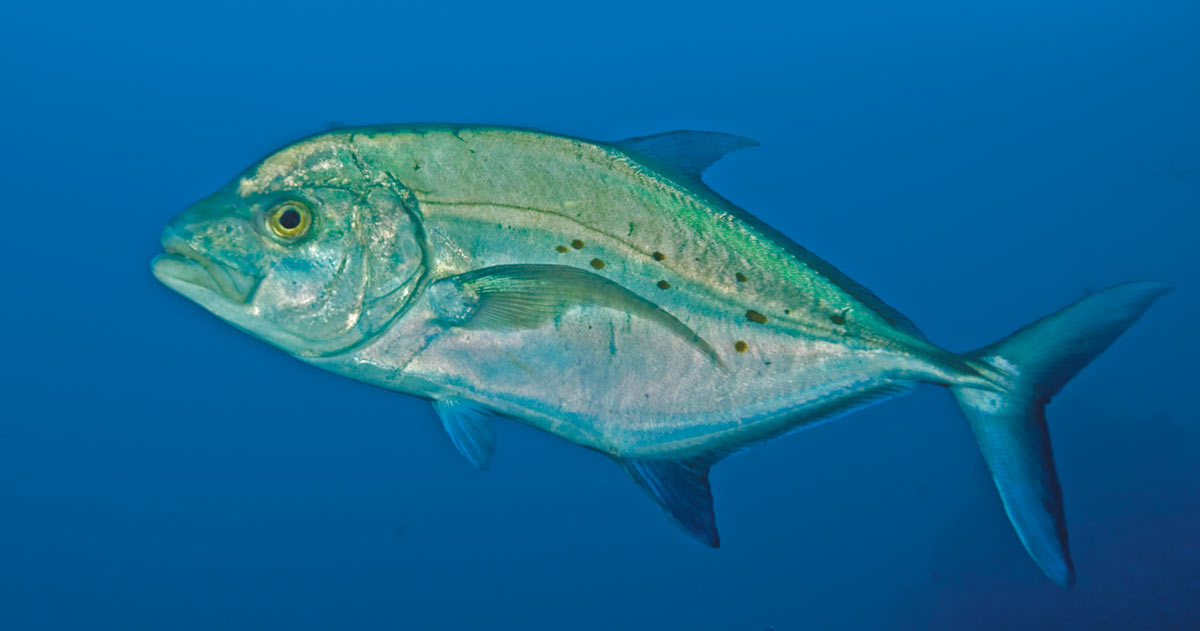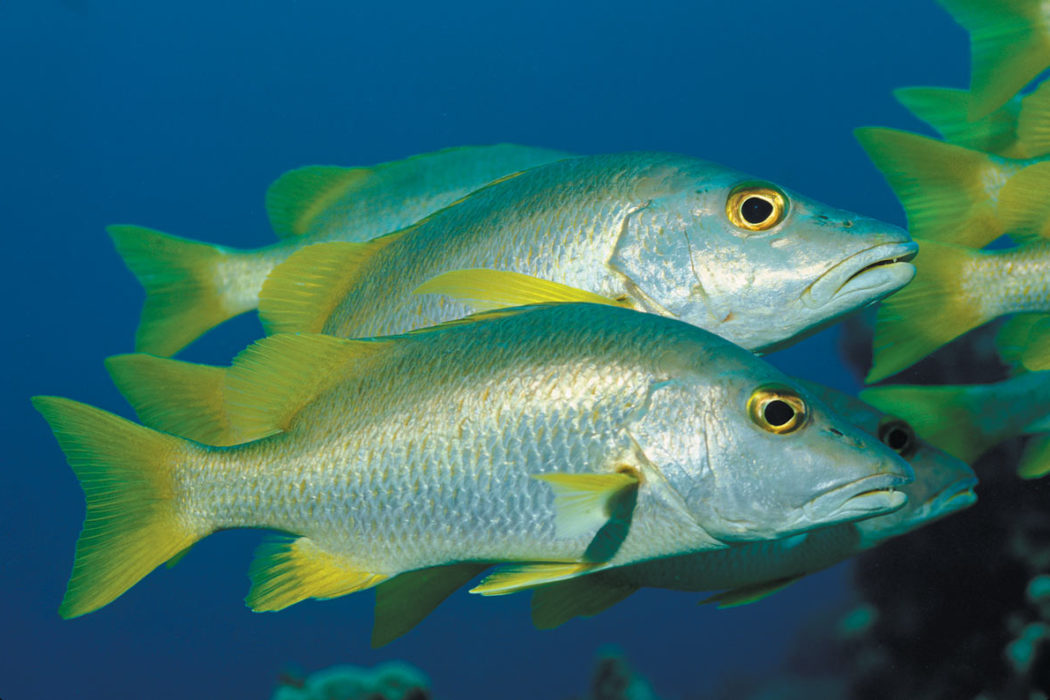After almost every dive someone immediately begins to try to describe a fish they saw. The first questions they are asked in response are “what did it look like, how big was it, what color was it, and what was it doing?” At that point you are very likely to hear something about the fish’s body shape, size and color, the look of its face, eyes and mouth, and a comment or two about whether the animal was striped or had spots or other distinct markings, and where the fish was seen. But only on rare occasions does anyone comment about a fish’s tail.
Whether the fish in question is big or small, a shark or a reef fish, especially attractive or average looking, the tail usually fails to get much consideration. Now I am not suggesting that you start looking at tails before you check out faces and bodies, but experienced divers, ichthyologists, and other marine specialists are quick to point out that a good look at an animal’s tail can not only help you identify a species, but understanding the advantages and disadvantages of various tail shapes can provide you with valuable insight about the natural history of fishes and many other marine creatures that we routinely encounter. In other words, a little knowledge gleaned from a closer look at the tails of marine animals will make you a much wiser diver.

A truncate, or broad and perhaps somewhat rounded tail is a good design for both acceleration and maneuverability. Many members of the family of sea basses and groupers are equipped with a truncate-to-rounded tail fin. Photo by Marty Snyderman.
Primary Purpose is Propulsion
The tail, also known as the caudal fin, is the primary source of propulsion for most fishes. Fish tails appear in a variety of significantly different forms depending upon the lifestyle of the species. Most fishes gain their thrust, the power that propels them forward through the water, by moving their tail from side to side while alternately curving the rest of their body from side to side. The primary function of the tail is to displace enough water with each stroke, or beat, an action that causes the fish to move forward. The actual forward thrust is produced via the pressure the moving tail creates as it pushes against the surrounding water. Some of the fastest-swimming fishes, species such as tunas and marlins, rely mainly on the movement of the tail for thrust. Other fishes, such as eels, depend primarily upon the curving motion of their body to achieve their forward movement.

Lunate, or crescent-shaped tails like those possessed by jacks and swordfish allow for great speed over long distance and are most often seen on fishes that live in the water column. Photo by Marty Snyderman.
Types of Tails
Specialists debate the number of definitions and ways that fish tails should be categorized or described, but it is safe to say that there are a variety of shapes found in the world of bony fishes and another handful in the cartilaginous fishes, the sharks, rays and skates.
Thin, lunate, or crescent-shaped, tails like those possessed by jacks and swordfish allow for great speed over long distance and are most often seen on fishes that live in the water column. A lunate tail is not advantageous for bottom-dwelling species or those that depend on their maneuverability for their survival, but it is an ideal design for producing speed.
A truncate or broad and perhaps somewhat rounded tail is a good design for both acceleration and maneuverability. Many members of the family of sea basses and groupers such as California’s giant sea bass (also known as the black sea bass), the Caribbean’s yellowmouth grouper and the gigantic grouper are equipped with a truncate-to-rounded tail fin. Studies have shown that some groupers can go from a hovering start to full speed in as little as 1/40th of a second. However, most species that are equipped with a large, rounded tail tend to tire quickly at least in part because a rounded tail fin creates increased drag, or resistance due to friction, as the fish moves through the water.
Less drag is produced by an emarginated-shaped tail such as those possessed by schoolmaster snappers and the freshwater fishes known as trout. An emarginated tail has a relatively broad surface but the surface is slightly indented in the center.
Eels provide classic examples of fishes with tail fins that are described as continuous, with the tail being hard connected to the body in such a way that it is difficult to say where the body stops and the tail starts. This type of tail fin helps eels and other fishes maneuver in and around the cracks and crevices of reef communities.
Interestingly, it has recently been discovered that in some species such as the mosquitofish (Gambusia affins) the presence of large numbers of potential predators causes the tails of prey fishes to grow longer. Longer tails translate into speed and the ability to escape predation. This discovery supports the belief that environmental factors as well as genetics play an important role in the body structure of many fishes.

Photo by Marty Snyderman.
Shark Tails
Sharks gain their forward thrust from the lateral movement of their tails. But not all shark tails are built the same. The tails of most sharks are asymmetrically shaped with the upper lobe being larger than the lower lobe. Certainly this is the case with species such as blue sharks, oceanic whitetips, silkies, Caribbean reef sharks and bull sharks. The asymmetrical shape tends to drive the animals in a downward direction toward the seafloor when the tail is moved from side to side. These species compensate for the downward force by using their pectoral fins to provide additional lift. Hammerhead sharks gain additional lift at the front of their bodies from the winglike shape of their heads. In addition, because the skeletons of sharks are made from cartilage, which is lighter than bone, the downward force is not as difficult for these species to overcome as it would be if their skeletons were composed of bones.
In contrast, the tails of great white sharks, makos, salmon sharks and porbeagles are almost perfectly symmetrical with the upper and lower lobes being almost mirror images of one another. Partly due to their large, symmetrically shaped tails, reinforced musculature near the tail and torpedo-shaped bodies, these species are among the fastest of all sharks. As is the case with all animals, the tail of these sharks is an important element, but it is only part of the overall speed and lifestyle picture.
The tail of some bottom-dwelling sharks, most notably the Indo-Pacific species known as the zebra shark, is rather long compared with the overall body length. In fact, the tail is nearly half as long as the rest of the body. When moved from side to side their tail provides great leverage when zebra sharks are trying to force their way under coral heads and ledges to pursue bottom-dwelling prey.
The tails of thresher sharks are even longer compared with the animals’ overall body size, with the tail being almost the same length as the body. All four species of threshers use their long tail to help them herd prey fishes such as anchovies into tight schools before the sharks rush through the schools to capture a meal.

Less drag is produced by an emarginated-shaped tail such as those possessed by schoolmaster snappers. An emarginated tail has a relatively broad surface but it is slightly indented in the center. Photo by Marty Snyderman.
Lobster Tails
The tail structure and shape of many invertebrates such as lobsters and shrimps also provide insight into the animals’ lifestyles. When burying themselves in the substrate or retreating into the deep recesses of a cave or hole doesn’t provide shrimps and lobsters with a means of escape from predators, often a quick forward snap of their tail will do the job. When flexing the tail, the end of the tail is quickly brought forward as it curls under the body creating a force that moves the animal backward through the water quite quickly. Most species of shrimps and lobsters can repeatedly flex their tails to cover a greater distance in a short period of time.
Instead of resting on the seafloor many shrimps inhabit the water column. Sometimes they hover almost motionless for long periods but when they choose to do so, they move about in erratic bursts of speed by flexing their tails.
A close look at the tails of lobsters can also help distinguish males from females. Most females have wider tails than the males of the same species. This is not surprising considering that the female often attaches her eggs to her tail before the young hatch. A wider tail provides additional space for carrying eggs.
In concluding this tale about tails, there is no doubt that close consideration of the shape and structure of the tail of many fishes and other marine animals will reveal a lot about an animal’s lifestyle and place in the marine environment. A tail is only part of the picture, but clearly it is a part worth noting.

Photo by Marty Snyderman.
Mammal Tails
Whales, dolphins and manatees are marine mammals, and as mammals, all are air breathers. No matter how deep they can dive or how long they can remain underwater, eventually all marine mammals must return to the surface to fill their lungs with life-sustaining air.
Instead of creating forward thrust by moving their tail from side to side as many fishes do, the tails of whales, dolphins and manatees move up and down. This design enables the tail to provide lift for these animals when they break the surface to breathe. Having their blowholes — the body openings to the air passage system — high atop their head also facilitates the breathing process as minimal effort is required to gain access to oxygen-rich air once the animal has reached the water’s surface.
The tails of whales, dolphins and manatees have two lobes, each of which is known as a fluke. Lacking both bones and muscles, the flukes are composed of rather dense fibrous tissue.
In addition to being used when swimming, the tails of whales and dolphins are often used in communication. It is quite common to see whales and dolphins raising their tail out of the water and then slapping it downward against the surface in a behavior known as lobtailing. This slapping motion can produce very loud sounds that are believed to sometimes serve as a warning to other members of their species that potential danger is near, to lay claim to territory during mating season, and perhaps just to entertain themselves when they play.

Photo by Marty Snyderman.
Not Every Speed Demon Has a Tail
While the structure, musculature and movement of a tail provides forward thrust for many fishes, mammals and other marine creatures, the use of a tail is not the only way that marine animals power themselves along their paths. Animals such as crinoids, sea stars, sea cucumbers and crabs “walk” from place to place. Squids, octopuses and cuttlefishes use a natural form of jet propulsion to power themselves through the water. These cephalopods move by filling with water their mantle, the soft external body wall below the head. They then forcefully eject powerful jets of water through a funnel-like organ connected to the mantle. It is an act that pushes the animal in the opposite direction of the jet of ejected water. The funnel is highly direct able, enabling these mollusks to move in any direction they desire to go. The force of the ejected water can also be regulated to control their speed.
Sea turtles use their powerful flippers to propel themselves. Sea lions rely upon their powerful fore flippers to gain thrust while using their rear flippers as a rudder. In contrast, seals acquire their thrust by using their strong rear flippers.
Despite lacking a powerful tail, squids, octopuses and turtles can move through the water at high rates of speed and can easily outdistance divers and snorkelers when they choose to do so.




